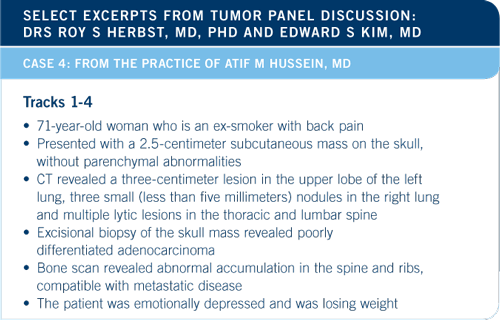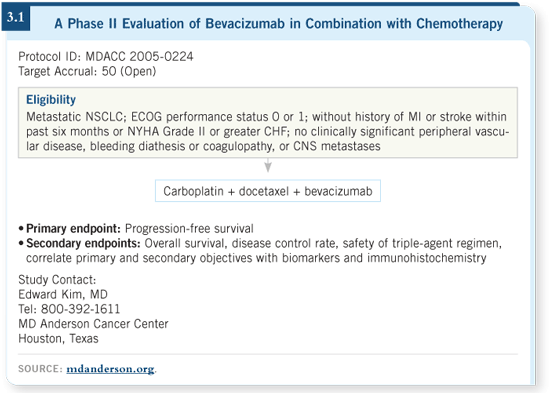
 DR LOVE: Ed, once her mood and appetite
improve, what therapy would you be
considering for this patient?
DR LOVE: Ed, once her mood and appetite
improve, what therapy would you be
considering for this patient?
 DR KIM: I would consider this woman
for combination chemotherapy with bevacizumab.
If she were being treated at MD
Anderson, I would put her on our Phase II
trial of carboplatin/docetaxel and bevacizumab
(3.1). Outside of a clinical trial, you
have the option of using either taxane with
carboplatin and bevacizumab.
DR KIM: I would consider this woman
for combination chemotherapy with bevacizumab.
If she were being treated at MD
Anderson, I would put her on our Phase II
trial of carboplatin/docetaxel and bevacizumab
(3.1). Outside of a clinical trial, you
have the option of using either taxane with
carboplatin and bevacizumab.
 DR HERBST: This is a patient who clearly
should receive the best therapy available,
which outside a clinical trial now includes bevacizumab. The median survival in the
ECOG trial of carboplatin/paclitaxel/bevacizumab
was more than 12 months for
the group receiving bevacizumab (Sandler
2005; [3.2]). She doesn’t have any contraindications
to the drug, and I believe this is a
reasonable approach.
DR HERBST: This is a patient who clearly
should receive the best therapy available,
which outside a clinical trial now includes bevacizumab. The median survival in the
ECOG trial of carboplatin/paclitaxel/bevacizumab
was more than 12 months for
the group receiving bevacizumab (Sandler
2005; [3.2]). She doesn’t have any contraindications
to the drug, and I believe this is a
reasonable approach.

 DR LOVE: Dr Hussein, can you follow up
on this patient?
DR LOVE: Dr Hussein, can you follow up
on this patient?
 DR HUSSEIN: I treated her with
narcotics for her pain and sent her for a
radiation oncology consult. She started
radiation therapy to the spine immediately.
The main trouble we are facing is
her appetite. I put her on megestrol acetate,
knowing it might increase the risk of deep
vein thrombosis but not knowing what
else to do. I think she would probably also
benefit from an antidepressant.
DR HUSSEIN: I treated her with
narcotics for her pain and sent her for a
radiation oncology consult. She started
radiation therapy to the spine immediately.
The main trouble we are facing is
her appetite. I put her on megestrol acetate,
knowing it might increase the risk of deep
vein thrombosis but not knowing what
else to do. I think she would probably also
benefit from an antidepressant.
In terms of chemotherapy, I started her on
carboplatin and docetaxel, and I irradiated
a large part of her spine. She also received
pegfilgrastim and zoledronic acid. I did not
want to start bevacizumab in the first cycle
because I’ve administered so many drugs
to her at the same time and because she has
the incision in her scalp and a port. I will
definitely be adding bevacizumab to her
second cycle.

Select publications

